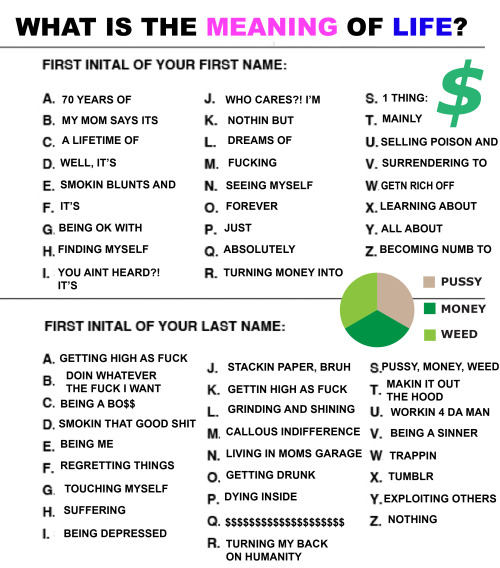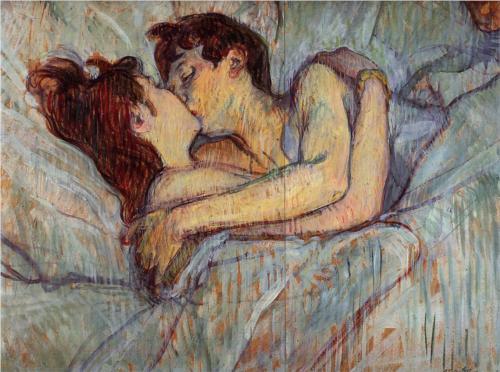70 Years Of Being A Boss. Yeah
70 years of being a boss. Yeah

What is the meaning of life?
More Posts from Arieso226 and Others
Alright😭😒


These, for me, are the two most depressing paintings in western history. They were painted by post-impressionist Henry de Toulouse-Lautrec, a man who, due to inbreeding, was born with a genetic disorder that prevented his legs from growing after they were broken. After being so thoroughly mocked for is appearance, he became an alcoholic, which is what eventually caused his institutionalization and death. His only known romantic relations were with prostitutes. And then he paints something like this which is so beautiful and tender and sentimental. It seems like the couple in bed really loves each other—cares about each other. Wakes up happy to look at each other. And I see that love and passion and I wonder how lonely he must have been. I wonder how he could paint something like this without it breaking his heart. Maybe they say artists should create what they know, not because its unbelievable when they extend themselves beyond their experiences, but because when they pull it off with such elegance, it’s so damn unbearable to look at. I hate thinking of Lautrec, wondering about the lovers he created and knowing it was beyond his experience. Creating something that he knows is beautiful and knows he’ll never really understand.
Mean World Syndrome
NO. 1
Mean World Syndrome is a theory the sociologist George Gerbner, creator of the Cultural Indicator’s Project, where three quarters of Americans believe in high level of crime, even though statistics show it is low. In the media, there is too much sex and violence, more so than the average person will ever see a day in their lives, and it has become repetitive, too routine, as the storytelling of violence seem ‘normal’. Since 1995, the demand for guns to ‘protect themselves’ has been at an all time high, and so is the fear, fear that everyone in the world is a suspect. But most importantly, is the image of the bad guys coming to get them. 2/3 of Americans get their information from the media, mostly the news, which creates negative stereotypes of minorities, who are seen as violent and aggressive.
NO. 2 Take for instance, Latina’s, who make up 15% in population in America, are portrayed by the media as aggressors, seen as ‘rapists and gangbangers’ or ‘murderers’. They are also the subject of illegal immigration, which all together creates dehumanizing effects. Then, there’s the vilification of Arabs and Muslims, as bloodthirsty terrorists, that are linked to violence and terror, and the subject of torture/ing of these people is ‘okay as long as it’s a good guy doing it’’. 39% of Americans actually believes that American-born Muslims are not loyal to the country’s ideals, and so not loyal to them. And finally, African-Americans are twice as likely to be seen as perpetrators. In the media, it is harmful showing black people as great middle/class, successful people, then as violent and aggressive in the next slide, as if to say some people choose that type of lifestyle, that they are simply a product of their environment. White people are five times more than likely to be criminalized by whites than black people, yet it’s not white people being shown almost everyday on the news for braking crimes.
The result of all this is the active fear in everyday Americans that makes us less likely to be compassionate, and more hardened to anyone and everyone. It also increases a high demand for national security, and believing that we have to lock these ‘criminals in cages where they belong.’
Cultivation Theory is the examination of the long term effects of television. Media cultivates a set of values, meanings, expectations, understanding, etc. which is the culture now in the modern century. Mass media replacement of community-based storytellers, it advances corporate interests (increasing profits and sales) since Americans spend a lot of time with the media. The effects are becoming more systemic and all encompassing. We need to start asking questions, like who is being represented in the media, who is the victim, and who is in the cast, and what are their fates. Who is generally casted as the good guy, and who is casted as the bad guy. We can look to the Media Database (IMDb) to see who is making the cultural object, and what is the main subject. Mean World Syndrome relates to this theory, through intersections of race, gender, ethnicity, criminal justice and the international border. We need to understand who is creating these TV shows/films, since America has such a global reach, it attracts the largest audience. Sociologists are not condemning media, but the constant repetition of ‘happy violence’—where in the film, show, or media, the good guy faces has a challenge, fights and action and explosions reoccurs, he stops the evil doer, saves the damsel, and the day is saved! It’s boring, cliché and the same story over and over again— and the various franchises and storylines springing from these corporations because it slows down progress and keeps negative stereotypes alive, some of them extremely damaging.

Also I think a lot of young people on the left are growing up without understanding "you can and will make mistakes in life and who you are is defined by how you move forward from them" and instead are doing things like "I must always be up the latest social justice language and must always avoid mistakes lest i be ostracized and cancelled for it so here is everything I support just so you don't think I don't support it, and I'll just feel bad and guilty for every mistake when I do make them and all this makes me a good person". It's like congrats you made Catholic guilt but woke
Avengers: Age of Ultron
"Shit." "Language, Tony!


🥲
Honorable mentions:
The last SAMURAI- white.
Prince of PERSIA- white.
Just shut up.
A hero can go anywhere, challenge anyone, as long as has the nerve
#percyjackson#heroesofolympus (via demigod26)
#percyjackson#pipermcclean
He's so handsome


Intersectionality in regards to social science
Modern society in America, as a fact, has adapted the constructed norms of the Victorian Era in England, by which I mean how economic class, race, and sexuality is managed, or for lack of a better term, is misconstrued with eurocentric ideals; Since the creation of the United States, the only way you would be able to receive the privileges society holds was if you were white, straight and economically secure.

Throughout the decade, society has changed drastically when it comes to talks on these particular subjects, but we still have a long way to go in advancing a better community for everyone. Intersectionality, created or introduced in the 1980s, ‘‘as a heuristic term to focus attention on the vexed dynamics of difference and the solidarities of sameness in the context of discrimination and social movement politics. It exposed how single-axis thinking undermines legal thinking, disciplinary knowledge production, and struggles for social justice. Over the intervening decades, intersectionality has proved to be a productive concept that has been deployed in disciplines such as history, sociology, literature, philosophy, and anthropology as well as feminist studies, ethnic studies, queer studies, and legal studies.’’

So intersectionality is quite popular in learning all these studies. Patricia Hill Collins, a sociologist famous for writing the book ‘Black Feminist thought’ and ‘Race, Class, and Gender, writes about the politics of gender and race, and how they shape and influence knowledge. Epistemology is the study of knowledge, and Collins theorized that race and gender are part of our ‘social being’. ‘‘Social science argues that to truly understand society and group life one must be removed from the particulars and concerns of the subjects being studied. In this way, subjects are turned into objects of study. Collins’ (2000) alternative epistemology claims that is it only those men and women who experience the consequences of social being who can select ‘topics for investigation and methodologies used’ (p. 258). Black feminist epistemology, then, begins with “connected knowers,” those who know from personal experience—Rather than believing that researchers can be value-free, Collins argues that all knowledge is intrinsically value-laden and should thus be tested by the presence of empathy and compassion. Collins sees this tenet as healing the binary break between the intellect and emotion that Eurocentric knowledge values.’’


The ancient world was full of textile masterpieces we can only imagine… but most of them have rotted away. So few of them have come down to us in these days that we think of metal and stone as the primary mediums for the oldest artworks. But there were tapestries and fabric work that would have rivaled the finest wrought gold and iron and the first cave paintings.
-
 mymultiverseofmadness reblogged this · 7 months ago
mymultiverseofmadness reblogged this · 7 months ago -
 mymultiverseofmadness liked this · 7 months ago
mymultiverseofmadness liked this · 7 months ago -
 starfruitjuice liked this · 7 months ago
starfruitjuice liked this · 7 months ago -
 starfruitjuice reblogged this · 7 months ago
starfruitjuice reblogged this · 7 months ago -
 sideeffectsmayinclude reblogged this · 10 months ago
sideeffectsmayinclude reblogged this · 10 months ago -
 justremainingmyself reblogged this · 10 months ago
justremainingmyself reblogged this · 10 months ago -
 justremainingmyself liked this · 10 months ago
justremainingmyself liked this · 10 months ago -
 oktasmt liked this · 1 year ago
oktasmt liked this · 1 year ago -
 artnewsmag liked this · 1 year ago
artnewsmag liked this · 1 year ago -
 superflutes liked this · 1 year ago
superflutes liked this · 1 year ago -
 tunsoffestivepuns reblogged this · 1 year ago
tunsoffestivepuns reblogged this · 1 year ago -
 handibles liked this · 2 years ago
handibles liked this · 2 years ago -
 x-relax liked this · 2 years ago
x-relax liked this · 2 years ago -
 dangerouscherryblossomjellyfish reblogged this · 2 years ago
dangerouscherryblossomjellyfish reblogged this · 2 years ago -
 dangerouscherryblossomjellyfish liked this · 2 years ago
dangerouscherryblossomjellyfish liked this · 2 years ago -
 fantatm reblogged this · 3 years ago
fantatm reblogged this · 3 years ago -
 fantatm liked this · 3 years ago
fantatm liked this · 3 years ago -
 defineshitposting reblogged this · 3 years ago
defineshitposting reblogged this · 3 years ago -
 brigatebajor reblogged this · 3 years ago
brigatebajor reblogged this · 3 years ago -
 mumshie reblogged this · 3 years ago
mumshie reblogged this · 3 years ago
26-year-old Anthro-Influencer Anthropology, blogger, traveler, mythological buff! Check out my ebook on Mythology today👉🏾 https://www.ariellecanate.com/
208 posts

